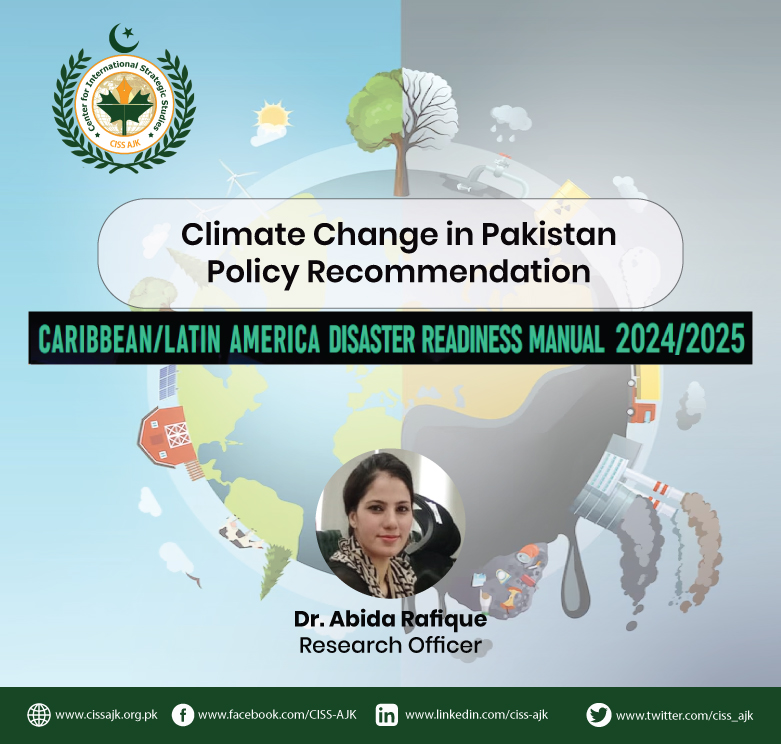558
Pakistan is one of the most vulnerable countries to climate change impacts. The country is experiencing a wide range of climate change-related challenges, including increasing temperatures, changing rainfall patterns, melting glaciers,
rising sea levels, and more frequent and intense extreme weather events such as floods and droughts. These
challenges have significant impacts on the country’s economy, environment, and social fabric.
There have been several recent developments regarding climate change in Pakistan like in August 2021, Pakistan
launched a countrywide plantation campaign called “Ten Billion Tree Tsunami” with the aim of planting ten billion trees
by 2023. This campaign is part of the larger “Billion Tree Tsunami” project that was launched in 2014. Also due to this
in Pakistan experienced record-breaking heat waves in 2021, with temperatures reaching as high as 48°C in some parts of
the country. The heat waves resulted in dozens of deaths and also led to power outages and water shortages.
It is a serious threat as Pakistan is home to some of the world’s largest glaciers, and their melting poses a serious threat to
the country’s water supply. A study published in the journal Nature in 2020 found that the glaciers in the Hindu Kush
Himalaya region, which includes Pakistan, could lose more than a third of their ice by the end of the century if global
warming continues at its current pace. Pakistan is also prone to floods and other extreme weather
events, which are expected to become more frequent and severe due to climate change. In July 2021, heavy monsoon
rains caused flooding and landslides in several parts of the country, leading to at least 62 deaths and displacing
thousands of people.
PAKISTAN and Policy
Overall, Pakistan is highly vulnerable to the impacts of climate change, and the country is taking steps to address the issue.
However, much more needs to be done to mitigate the effects of global warming and to adapt to the changing climate.
However, it’s important to note that Pakistan is highly vulnerable to floods, and the country has experienced
devastating floods in the past. The most recent major floods in Pakistan occurred in 2020, when heavy monsoon rains caused flooding and landslides in several parts of the country. The floods resulted in at least 136 deaths and affected more than 1.7 million people, according to the National Disaster
Management Authority (NDMA) of Pakistan.
In response to the 2020 floods, the Pakistani government and humanitarian
organizations provided emergency relief and assistance to affected communities,
including food, shelter, and medical care. However, the recurring nature of floods in
Pakistan highlights the need for long-term solutions to mitigate the impacts of climate
change and improve the country’s resilience to extreme weather events.
Pakistan is prone to floods, and it is important to take appropriate measures to
mitigate their impact. Here are some recommendations to address this issue:
1. Improve early warning systems: Pakistan needs to improve its early warning systems for floods to provide timely and
accurate information to people living in flood-prone areas. This can help in reducing the loss of life and property.
2. Develop flood-resistant infrastructure: The construction of flood-resistant infrastructure, such as embankments, canals, and
water reservoirs, can help in reducing the damage caused by floods.
3. Promote sustainable land use practices: Deforestation and inappropriate land use practices such as urbanization and
agriculture on steep slopes can increase the risk of floods. Therefore, it is important to promote sustainable land use
practices that reduce the risk of floods.
4. Develop community-based flood management plans: Community-based flood management plans can help in reducing the
risk of floods and their impact. These plans should involve local communities in identifying flood-prone areas, developing
early warning systems, and implementing preparedness and response measures.
5. Promote climate change adaptation measures: Pakistan needs to promote climate change adaptation measures such as
water conservation, rainwater harvesting, and drought-resistant crops to reduce the impact of floods and other extreme
weather events.
6. Strengthen disaster management capacity: Pakistan needs to strengthen its disaster management capacity to ensure
effective response and recovery from floods. This includes improving coordination between different government agencies,
developing contingency plans, and ensuring adequate resources are available for disaster response and recovery.
The Pakistani government is taking steps to address the issue of climate
change, including the launch of initiatives like the Ten Billion Tree Tsunami and the Climate Change Policy.
However, more needs to be done to mitigate the impacts of climate change,
including developing climate-resilient infrastructure, promoting sustainable
land use practices, and reducing greenhouse gas emissions.



